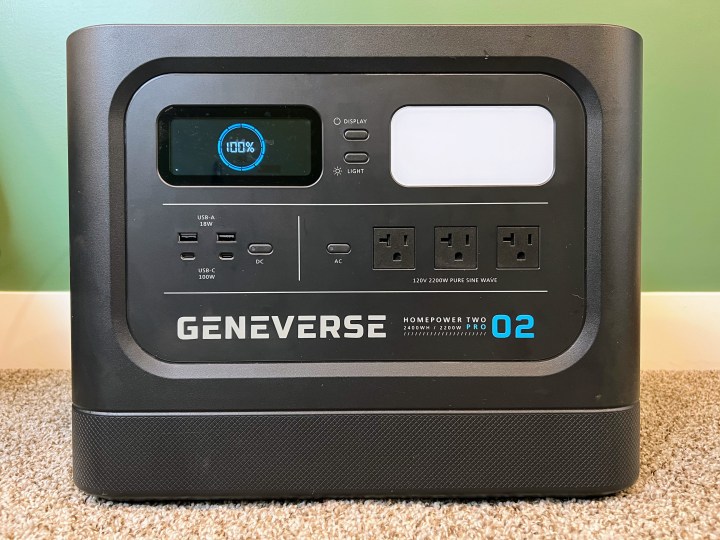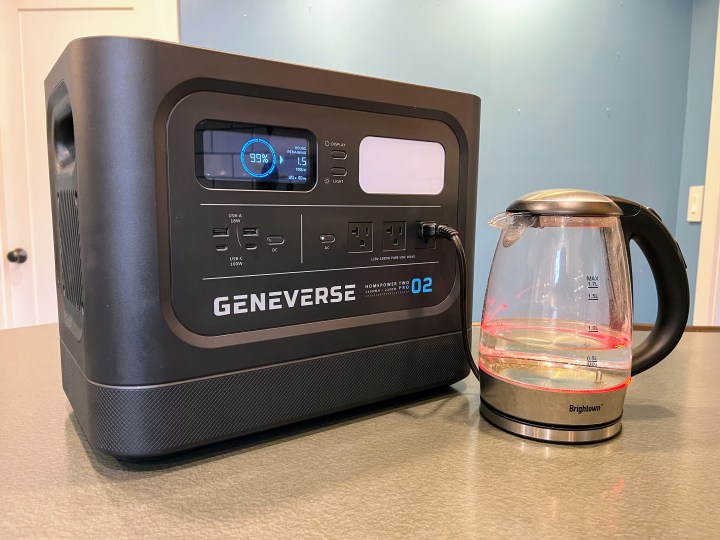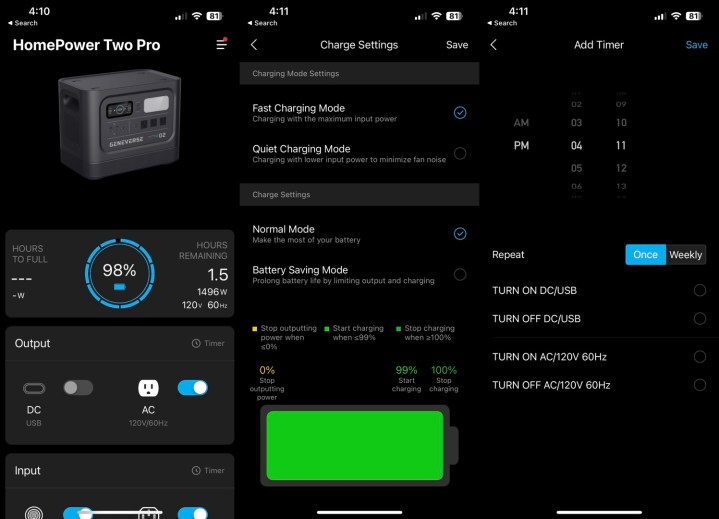
“When the big one hits, dust off the Geneverse HomePower Two Pro and keep life humming.”
- Huge 2.4kWh capacity
- Outperforms rated 2,200-Watt output
- Sturdy build quality
- Attractive minimalist design
- Speedy recharge time under 2 hours
- Expensive for the capacity
- App won’t work without Wi-Fi
- No wheels, 12V or 30A RV output
If Jackery is the Subaru of the portable power station world – rugged, capable, and adventurous – Geneverse might be the Lexus – staid, reliable, and luxurious. As the name implies, the HomePower line is intended less for off-the-grid campers to refrigerate their microbrews, and more for families to make sure the milk doesn’t spoil the next time a storm rolls through.
Geneverse’s largest model, the HomePower Two Pro, goes big on capacity to promise “seven days of essential power.” While that number will obviously differ for every user, we found that it lives up to its sterling promises of capacity and output, and we’d be happy to have one stowed in the basement for the next big outage.
Is that a Mac?
The HomePower’s intended domestic habitat comes across in the clean, appliance-like design, which almost calls to mind the way Apple might design a power station. It has a minimalist, unobtrusive look that you probably wouldn’t mind leaving on your kitchen counter for a few days, unlike the loud outdoorsy aesthetic of Jackery, or the alien look of Anker.

The flat top makes an ideal spot to rest gadgets as you charge them, and the burly handles built into the side don’t flex or groan – this thing is built like an anvil. We’d appreciate wheels on our anvil, though. At 61 pounds, the HomePower Pro Two is right at the limit of what many people will be able to comfortably (or safely) lift solo.
With 2.4kWh of battery capacity, the HomePower Pro tops its class for a standalone power station this size. The competing Anker 767 (2.0kW) and Jackery Solar Generator 2000 (2.2kWh) can’t touch it, and while the EcoFlow Delta Pro bests it with 3.6kWh, it also weighs a backbreaking 99 pounds, so it’s not truly in the same class. An output of 2,200 watts is right on par with most units this size and means the Geneverse will essentially power almost anything you can plug into a 20A home outlet.
The HomePower Two Pro didn’t flinch at a 1,300-watt space heater running on high.
Despite the impressive power it packs, the HomePower Two Pro comes up light on ports. We can excuse three AC outlets instead of the usual four – that’s easy to solve with a power strip – but the lack of a 12V car socket is pretty inexcusable for a system this size. RVers will also be disappointed by the lack of a 30A outlet, which the Anker 767 and Bluetti AC200MAX both pack. Neither port is strictly necessary for a home backup scenario, but it’s disappointing to see them omitted when cheaper models include them.
The heat is on
All those numbers mean nothing if the Geneverse can’t deliver when the power is down, so to prove the Geneverse can deliver every bit of its claimed 2,200-watt output, we rounded up a rogue’s gallery of electricity hogs and got to work plugging them in. When the HomePower Two Pro didn’t flinch at a 1,300-watt space heater running on high, we threw caution to the wind and gave it a veritable torture test by also flicking on a 1,500-watt heat gun.
Somehow, despite reading 2,764 watts, nearly 600 more than it’s rated for, the Geneverse held strong for 30 seconds before eventually shutting itself down. This isn’t a load you’d want to continually expose the unit to, but it was impressive to see how long it would sweat it out above its limit.
To test its surge capacity, we tried connecting the HomePower Two to a 13-inch DeWalt planer, a small pancake air compressor, and a 12-inch DeWalt miter saw that has been known to trip the 20A breakers in my garage on startup. While it handled the first two, the miter saw proved to be too much – it triggered an error and shut off the saw every time. Anker’s 767, in contrast, managed to handle it without issue.

When it’s time to fuel up, the Geneverse doesn’t fool around, slamming about 1,450 watts from the wall for total recharge times under two hours. That’s a hair lower than the rated 1,500 watts but still impressive.
User interface and app
The screen on the Geneverse is like nearly every other power station we’ve ever reviewed, which is a good thing. It’s a simple layout (input on the left, output on the right, charge capacity in a center ring) that doesn’t need reinvention.
Like most power stations in this price class, the Geneverse HomePower Two Pro comes with an iOS and Android app to keep tabs on power away when you’re away from the screen. You get all the same information from the screen, plus some more advanced options that would be too difficult to program with buttons. For instance, you can set timers to power different circuits on and off at designated times, which could be useful to cut down on standby consumption. You can also switch to a battery-saving mode to prolong its life, or monitor usage statistics.

The only notable omission is the ability to set a cap for charging wattage, which you’ll miss if you start popping breakers with this monster’s 1,450-watt charging rate. The next best thing is a “quiet mode,” which caps input around 530 watts and turns off the fans.
One maddening thing about the app: it connects via Wi-Fi rather than Bluetooth. That means that during a power outage where your router may be knocked out, or when camping, the app won’t connect. Competing apps from Anker and Bluetti use Bluetooth, which makes much more sense.
Solar options
With two 8020 solar connectors (big DC barrel jacks) on the back, the HomePower Two Pro can handle up to a combined 800W of solar input. That’s frankly more than you’ll probably be able to achieve with the offered accessories. Geneverse offers folding panels in 100- and 200-watt-per-panel flavors. You’d need four of the latter to hit capacity – a $2,516 purchase.
That’s expensive even by the marked-up standards of portable solar panels. A single 200-watt Geneverse panel goes for $629, while Anker only charges $549 for its panel, and Bluetti charges $449. All three use monocrystalline cells and claim 23% efficiency, but different connectors on the competitors would prevent you from simply using a competing panel with this power station unless you want to get into adapters.
We’ll give Geneverse credit for staying cutting-edge in its solar tech — it’s one of only a couple of companies that offer bifacial solar panels, which can absorb reflected light from behind them, making them more efficient. Geneverse sent us a pair for evaluation, and we’ll be providing an update on performance after a more thorough evaluation.
Power to spare, for a premium
If you need every drop of its best-in-class 2.4kWh capacity, the $2,499 Geneverse Homepower Pro Two makes a capable and reliable home backup solution. You’re paying a big premium to be at the top of the heap on capacity in this size, but the clean design and five-year warranty make it a little easier to swallow.
If you can live with just a fraction less capacity, a number of other alternatives offer more features for less money. The Jackery Explorer 2000 Pro brings a 12V DC output for $2,099, the Anker 767 brings a smarter design with wheels and a telescoping handle for $1,999, and both the EcoFlow Delta Max 2000 and Bluetti AC200MAX offer modular expandability for $1,599 and $1,699, respectively.
Editors' Recommendations
- EcoFlow launches Delta 2 Max solar generator for home emergencies and outdoor adventures
- Generark HomePower 2 emergency backup generator can charge EVs and much more
- This portable power station has 6 AC outlets and can charge a Tesla


